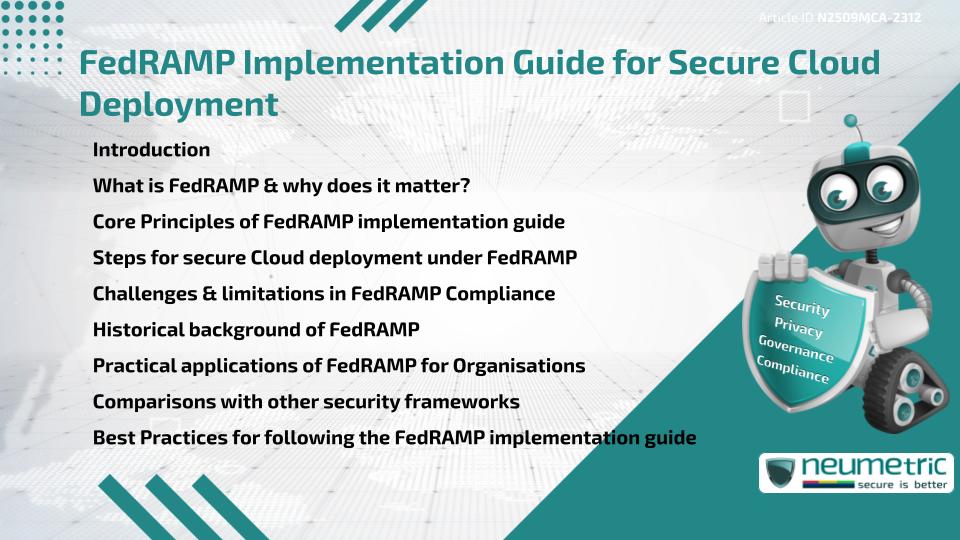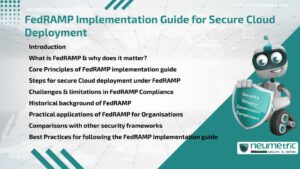Table of Contents
ToggleIntroduction
The FedRAMP implementation guide is a structured Framework that ensures Cloud systems used by United States federal agencies meet strict security requirements. It provides a standardised approach to assessing, authorising & monitoring Cloud products & services. Organisations aiming to work with the federal Government must adopt this guide to guarantee Data Protection, Risk Management & Compliance. By following the FedRAMP implementation guide, businesses can securely deploy Cloud solutions, streamline Audits & build Trust with federal Stakeholders.
What is FedRAMP & why does it matter?
The Federal Risk & Authorisation Management Program [FedRAMP] is a Government-wide initiative that standardises Cloud Security practices. It matters because it reduces duplicate Security Assessments, saves time & ensures consistency across agencies. Without FedRAMP, each agency would evaluate Cloud Providers independently, leading to inefficiency & inconsistent results.
FedRAMP Compliance is mandatory for Vendors providing Cloud services to federal agencies. This requirement ensures that Sensitive Information is safeguarded against Cyber Threats & Unauthorised access.
Core Principles of FedRAMP implementation guide
The FedRAMP implementation guide rests on a few essential principles:
- Standardisation: All agencies & providers follow the same set of Controls.
- Risk-based approach: Security is tailored to system impact levels (low, moderate or high).
- Continuous Monitoring: Security does not stop after authorisation but is maintained through ongoing Assessment.
- Transparency: Documentation & results are made accessible to agencies for reuse.
These principles ensure Accountability & reduce the Likelihood of breaches.
Steps for secure Cloud deployment under FedRAMP
The FedRAMP implementation guide recommends a step-by-step process for Cloud deployment:
- Categorise information systems based on impact level using the Federal Information Processing Standard [FIPS] 199.
- Select Security Controls from the National Institute of Standards & Technology [NIST] Special Publication 800-53.
- Implement Controls & prepare detailed documentation.
- Assess Security Controls through an accredited Third Party Assessment Organisation [3PAO].
- Authorise the system by either a Joint Authorisation Board [JAB] or an individual agency.
- Monitor continuously to maintain Compliance & manage Risk.
Challenges & limitations in FedRAMP Compliance
Despite its benefits, following the FedRAMP implementation guide can present challenges:
- Time & Cost: Achieving authorisation is resource-intensive.
- Complex documentation: Providers must prepare extensive materials.
- Constant monitoring: Continuous oversight requires dedicated staff & tools.
Some argue that the Framework may be too rigid, making it harder for smaller providers to participate. Nonetheless, the standardisation ensures fairness & consistency.
Historical background of FedRAMP
FedRAMP was launched in 2011 as a response to the increasing reliance on Cloud services by federal agencies. Before its creation, agencies conducted their own evaluations, often duplicating efforts. The program built upon existing NIST standards & introduced a Government-wide approach.
Practical applications of FedRAMP for Organisations
For Organisations, the FedRAMP implementation guide provides:
- A clear roadmap for achieving Compliance.
- Opportunities to expand into the federal market.
- Assurance that their systems meet high security standards.
Many private companies also adopt FedRAMP controls voluntarily to strengthen their internal security.
Comparisons with other security frameworks
FedRAMP is often compared with other frameworks like ISO 27001 or SOC 2. Unlike these, FedRAMP is specifically tailored for federal use & requires authorisation from Government bodies. While ISO & SOC 2 emphasise flexibility for business, FedRAMP enforces strict uniformity.
This makes FedRAMP more demanding but also more reliable in protecting sensitive Government data.
Best Practices for following the FedRAMP implementation guide
Organisations can make the process smoother by:
- Starting early with Gap Assessments.
- Engaging with experienced consultants or 3PAOs.
- Maintaining organised Documentation.
- Automating Continuous Monitoring tasks.
- Training staff on Compliance Requirements.
These practices help avoid delays & ensure successful authorisation.
Takeaways
- The FedRAMP implementation guide is essential for secure Cloud deployment in the federal sector.
- It standardises Security Practices across agencies.
- Compliance involves categorisation, control selection, implementation, Assessment, Authorisation & Monitoring.
- Challenges include cost, time & documentation complexity.
- Best Practices can ease the process & ensure smoother adoption.
FAQ
What is the purpose of the FedRAMP implementation guide?
Its purpose is to provide a consistent & secure Framework for Cloud Providers serving federal agencies.
Who must comply with the FedRAMP implementation guide?
Any Cloud Service Provider that wants to work with United States federal agencies must comply.
How long does FedRAMP authorisation take?
The process can take several months to over a year depending on complexity, preparation & system size.
What are the levels of FedRAMP authorisation?
FedRAMP has three levels: low, moderate & high impact, based on the sensitivity of the data handled.
How does FedRAMP differ from SOC 2?
SOC 2 is voluntary & business-oriented, while FedRAMP is mandatory for federal Cloud services & far more prescriptive.
Can private companies use the FedRAMP implementation guide?
Yes, many private companies adopt it to strengthen security & prepare for potential federal contracts.
What happens if a provider fails Continuous Monitoring?
The authorisation can be revoked, preventing the provider from offering services to federal agencies.
Need help for Security, Privacy, Governance & VAPT?
Neumetric provides organisations the necessary help to achieve their Cybersecurity, Compliance, Governance, Privacy, Certifications & Pentesting needs.
Organisations & Businesses, specifically those which provide SaaS & AI Solutions in the Fintech, BFSI & other regulated sectors, usually need a Cybersecurity Partner for meeting & maintaining the ongoing Security & Privacy needs & requirements of their Enterprise Clients & Privacy conscious Customers.
SOC 2, ISO 27001, ISO 42001, NIST, HIPAA, HECVAT, EU GDPR are some of the Frameworks that are served by Fusion – a SaaS, multimodular, multitenant, centralised, automated, Cybersecurity & Compliance Management system.
Neumetric also provides Expert Services for technical security which covers VAPT for Web Applications, APIs, iOS & Android Mobile Apps, Security Testing for AWS & other Cloud Environments & Cloud Infrastructure & other similar scopes.
Reach out to us by Email or filling out the Contact Form…





